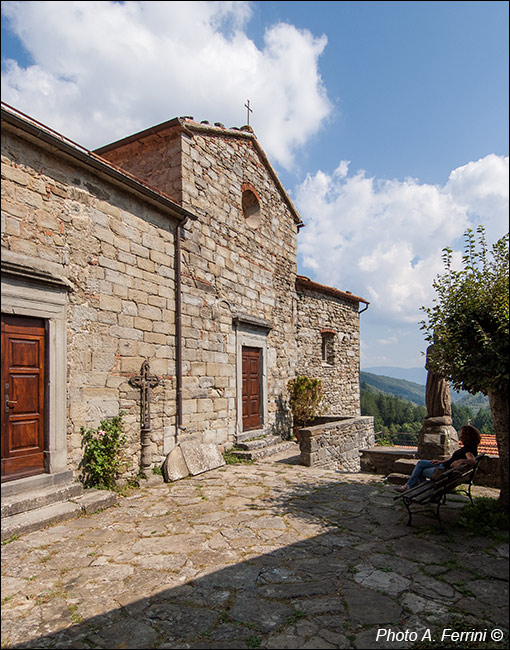Carda
in Casentino, una bella valle Toscana che puoi conoscere in ogni suo dettaglio con questo sito
Italiano
APPARTENNE A UN'ABBAZIA ARETINA
La Chiesa di Carda dedicata alle Sante Flora e Lucilla (martirizzate nel 260 circa) vista dall'antistante piazzetta. L'edificio si presenta con forme anomale, cosa che noteremo ancor di più all'interno. Questo è dovuto a rifacimenti e ampliamenti che si sono susseguiti nel tempo, compreso un cambio di orientamento. Le reliquie di Flora e Lucilla (sorelle) si trovano nella Chiesa della Badia di Arezzo dedicata, appunto, a queste sante. Un edificio facente parte di un grande complesso monastico realizzato ad inizio XIII secolo che andò a sostituire quello originario fuori le mura della città. Oggi questa chiesa è un luogo d'arte di notevole importanza (vi sono conservati dipinti di Giorgio Vasari che nel 1565 progettò anche il rifacimento del sacro edificio). Tra le opere qui presenti è da porre attenzione a una singolare "finta cupola", un dipinto del 1702 di Andrea Pozzo posto sul soffitto, sopra l'altare maggiore.
L'appartenenza di Carda alla Badia di Arezzo durò fino al 1280 circa. Dopo questa data il luogo figura di proprietà della potente famiglia degli Ubertini che proprio in quel periodo aveva Ubertino come Vescovo di Arezzo, un risoluto uomo politico, nonché un grande condottiero che morirà nel 1289 mentre comandava le truppe aretine nella Battaglia di Campaldino contro i guelfi fiorentini.
The Church of Carda dedicated to Saints Flora and Lucilla (martyred around 260) seen from the small square in front. The building has anomalous shapes, which we will notice even more inside. This is due to renovations and expansions that have followed one another over time, including a change in orientation. The relics of Flora and Lucilla (sisters) are located in the Church of the Badia di Arezzo dedicated, precisely, to these saints. A building that is part of a large monastic complex built at the beginning of the 13th century that replaced the original one outside the city walls. Today this church is a place of art of considerable importance (it houses paintings by Giorgio Vasari who in 1565 also designed the renovation of the sacred building). Among the works present here, attention should be paid to a singular "false dome", a 1702 painting by Andrea Pozzo placed on the ceiling, above the main altar.
Carda's ownership of the Badia di Arezzo lasted until around 1280. After this date, the place was owned by the powerful Ubertini family, who at that time had Ubertino as Bishop of Arezzo, a resolute politician and a great leader who died in 1289 while commanding the Arezzo troops in the Battle of Campaldino against the Florentine Guelphs.

















































